The Pros and Cons of Twitter Ads
Twitter ads are among the most underutilized paid social media marketing tools. Yet, when used properly, they can be one of the most powerful and efficient lead drivers available to B2B marketers. This article will explore the strategic benefits and drawbacks to using Twitter ads, as well as a tactical implementation plan if you believe that Twitter ads are a good fit for your business.
The Pros of Twitter Ads:
- You only pay for performance. Unlike other platforms where you might not achieve your desired object and invest hundreds or thousands in the meantime, Twitter only bills based on achievement of your goal/action (ex. You pay for clicks or installs rather than engagements and impressions).
- Limited competition. As compared to the other social platforms that are home to millions of advertisers, Twitter is only home to 130,000 business advertisers.
- Low CPC. In Q3 of 2017, Twitter reported that cost per engagement declined 54 percent year-over-year while ad engagements increased 99 percent in that same period. The result? Clicks can actually cost cents on Twitter.
- Link embedding. For years, link embedding was never an option on Twitter, but that has recently changed, allowing advertisers to hyperlink blog posts or feature previews instead of just a shortened URL like the olden days.
- Keyword targeting. This is a unique Twitter ads feature whereby you can target specific tags that your desired audience might be engaging with (ex. You could use #ppcchat if you’re a marketing agency and want to engage with the PPC community on Twitter).
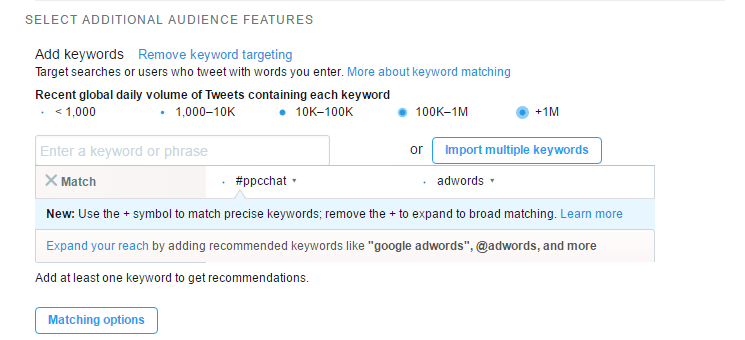
The Cons of Twitter ads:
- Limited analytics. The breadth and precision of Twitter analytics are not comparable to that of Facebook or Google, so don’t expect any advanced features to accompany your campaigns on this platform.
- Twitter is cluttered. This is a user experience bit, and unlike Instagram where it’s almost impossible to miss an ad, Twitter users might just stumble right past your content.
- Limited audience. As of 2019, Twitter was reporting 330 million monthly active users, which is still more than LinkedIn, but much less than Facebook and Instagram. LinkedIn is also a more focused B2B platform as compared to Twitter.
How to launch a Twitter ad campaign
1. Start with your unique selling proposition (USP)
If you haven’t already, use the tactics outlined in the Facebook Ads article to help you isolate your USP.
2. Choose your ad objective
Here are your choices:
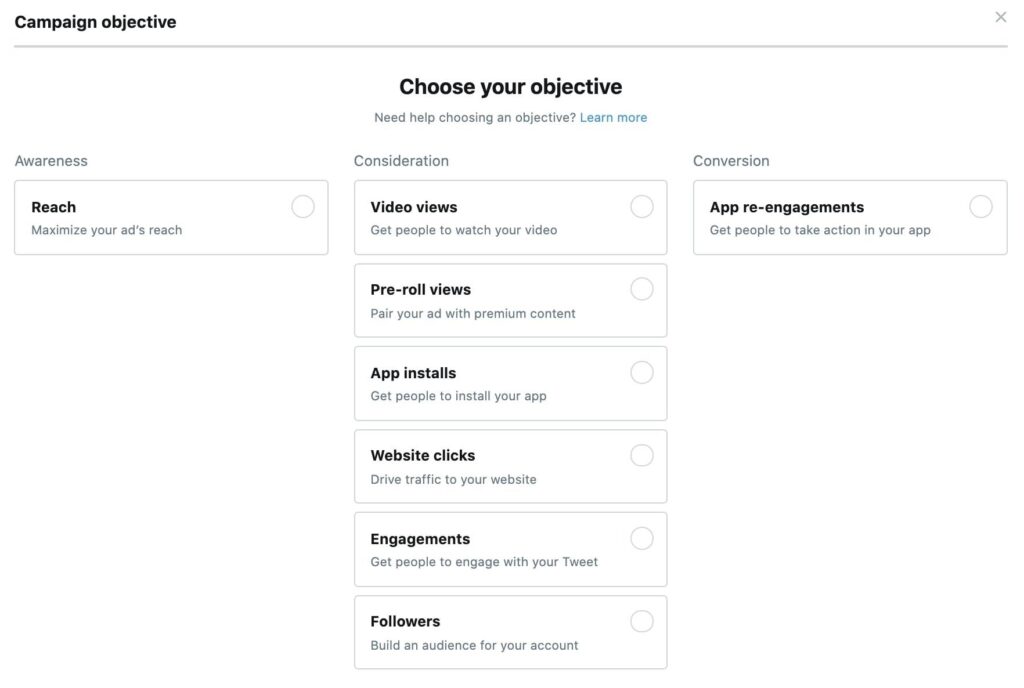
Here are some additional details to help guide your objective selection:
- Awareness
- Reach. Classic billboard-style advertising. The more eyeballs, the better, and you’re billed per 1,000 impressions.
- Consideration
- Video views. A little further down the funnel, you might want to introduce a salesy video. You get billed per view.
- Pre-roll videos. Your video ads get put in front of the videos of premium content partners, and you get billed per view.
- App installs. Great for SaaS companies looking for a quick download, and you only get billed per download.
- Website clicks or conversions. Classic digital ad CTA where you will get billed per website visit.
- Engagements. Best paired with promoted tweets that you’re aiming to maximize likes, replies, and shares for. You are then billed per engagement.
- Followers. Best paired with a promoted accounts campaign and you will be billed for each new follower that you acquire.
- Conversion
- App re-engagements. Get existing app users to get back into your app, and you’re billed for each app click.
3. Choose your ad format
On Twitter, there are only a few different ad formats that make it rather simple for users to launch B2B campaigns.
Here are the available Twitter formats:
- Promoted tweets. These are your standard newsfeed ads that are prompted to people outside of your existing audience. These ads consist of text, image/video (with video autoplay), as well as hyperlinked URLs. These ads will appear in user timelines, on user profiles, and at the top of search results for both mobile and desktop users.

- Promoted accounts. This is an opportunity to promote your brand’s entire Twitter account. These ads are displayed in potential followers’ timelines, the “Who to follow” suggestions pane, as well as search results windows.
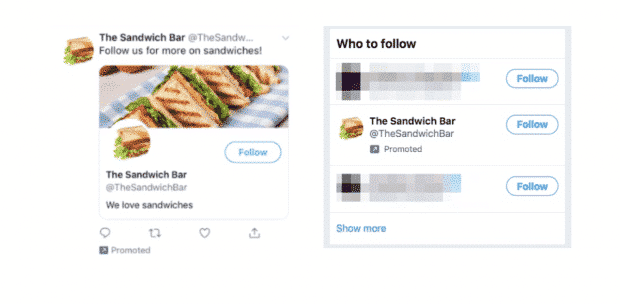
- Promoted trends. A promoted trend shows up on the right-hand side of the newsfeed on desktop as well as the first result in the “For you” section under explore. When clicked, trends will see the search results for that topic, but with one of your branded tweets as the top result. As seen below, Twitter also recently released video and GIF support for this ad type.
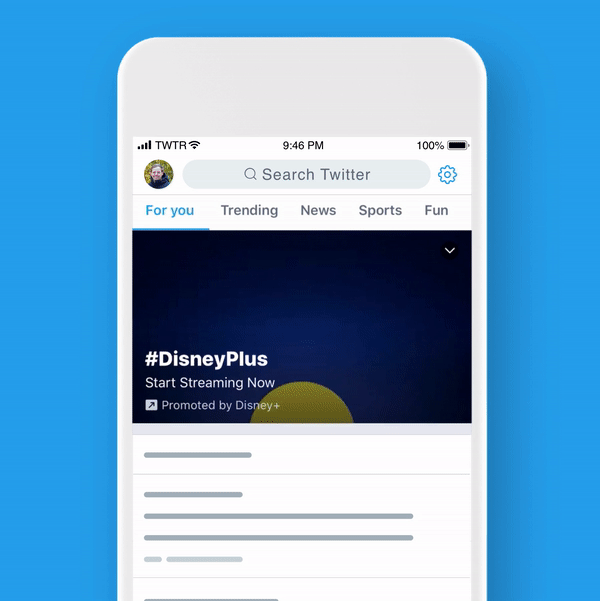
- Promoted Moments. These are essentially Twitter story ads, allowing users to curate a collection of similar tweets that tell a story.
4. Create your audience
Twitter allows users to create audiences from a variety of demographic, audience, and custom features. The most unique segmentation variables are surrounding the ability to isolate Twitter users based on the conversations that they might be participating in on the platform, as well as targeting users based on their movie and TV preferences as a key interest variable.
Here are some of those features:
- Demographics
- Geography, gender, language, and age.
- Device models, carriers, OS versions, and platforms.
- Audience features
- Conversation targeting.
- Event targeting.
- Tweet Engager targeting.
- Keyword targeting.
- Movies and TV show targeting.
- Interest and follower lookalike targeting.
- Custom audiences
- Audiences from lists.
- Audiences from the web.
- Audiences from mobile apps.
Find out more details on these ad formats here.
5. Set up your ad group and bidding strategy
Twitter is somewhat unique when it comes to ad groups and bidding strategy. Although it might be easier to stick to a single ad group, you should run multiple so that you can experiment with different audiences, creative, timing, budget, and more.
Other platforms generally don’t allow you to target different audiences within the same campaign, so this can be a great way to test theories and prove hypotheses without costing you too much time.
Now, it’s time to set your bid type. For those new to Twitter ads, “automatic bidding” can be a great way to see how bidding works and establish benchmarks for future campaigns without blowing your budget. However, if you want to get serious about your Twitter ad game, then you may want to test “target cost” and “maximum bid” options.
Why target cost?
- You identify what an action (website clicks) is worth to you (ex. $4.00).
- The Twitter ad algorithm will win you bids at auctions above and below this mark (ex. $3.50 and $4.50) to create this average, providing access to larger markets that may have exceeded a set price.
Why maximum bid?
- You determine the most that you’re willing to pay for an action at auction, setting a firm ceiling on your ad spend.
- The ad algorithm will still win auctions that are below your maximum bid.
6. Write your ads
There are a few things you’re going to want to keep in mind as you craft text content for Twitter:
- Clear
- Concise
- And compelling
H*ll, we could even call it the 3 C’s of Twitter text. But that’s pretty much it. Twitter is an impact-first platform, so the more you can say in fewer words, the further your message will carry. Oh, and make sure you do it in less than 280 characters or else Twitter is actually going to cut you off (you should aim for less than 140 characters).
This same logic should go into your CTAs as well. There should be no confusion surrounding the action that you are trying to solicit.
For enhanced Twitter CTAs, consider the following:
- Match language and style to your ad objective. If video views are your primary objective, then don’t try to also redirect traffic to your site with a shortened link.
- Experiment with CTA styles (shortened links, embedded links, Twitter page views, etc).
- Make it direct. Soft sells and obscure offers don’t work on Twitter. Clearly explain the offering in text, and then state the CTA directly.
7. Create visual content
When words aren’t exactly the emphasis, visuals become even more important. First of all, you’re going to want to be sure that you’re adhering to Twitter’s creative ad specs (which can be found here).
Some tips for greater visual impact on Twitter include:
- Quality first. There’s no room for miss-sized or low-quality pictures and videos on Twitter.
- Make sure your imagery is eye-catching so that users actually stop scrolling through their feed.
- Leave some ambiguity so that the user takes the time to read the post and digest the CTA.
- Get creative surrounding events. Being that Twitter is highly frequented as a news outlet, event-based strategies can be highly effective.
Check out this March Madness related ad by Wendy’s:
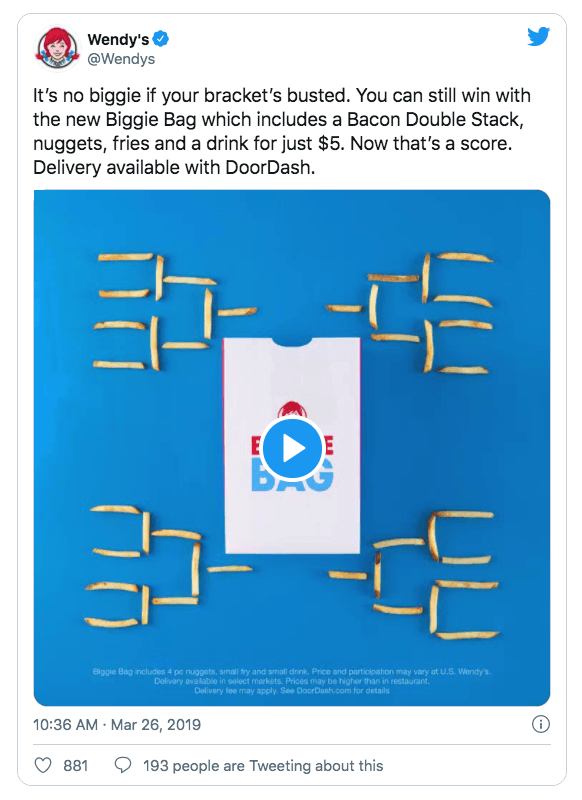
8. Monitor performance and optimize
Here are the best optimizations you can make with the help of your Twitter Analytics dashboard:
- Kill the worst performers. If campaigns are under-performing as compared to expectations and other campaign variations, then they should be tweaked or replaced with new challengers.
- Consider increasing your bid on campaigns that are performing well and may reach a larger audience with a larger bid.
- Replace creatives on long-running ads to minimize wear out.
- Try injecting stats or data points into the text of lower performance ad variants.
- Consider separating mobile and desktop targeting and run different ads to each. Mobile users are more receptive to shorter, more engaging copy/visuals, whereas desktop users might be more responsive to more in-depth ad content.
Find additional insights from Twitter here.
